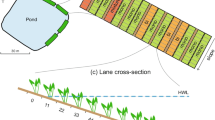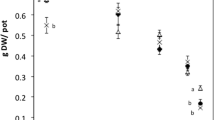Abstract
Several plant species of wetland habitats expand through clonal growth, often forming dense, nearly monospecific stands. Adjoining interspecific colonies represent an ideal model for testing hypotheses about competitive interactions between clonal species and developing predictive theories on plant competition for space. In this study, we evaluated the outcome of competition between colonies of Phragmites and Typha. First, we compared the progression and density of colonies in roadside ditches 1) at the zone of contact of two well-established monospecific colonies, and 2) in zones where the progression fronts are free from competition. Second, we used an experimental mesocosm approach to simulate competition for space between two plant colonies. The experiment was done under three salinity levels in order to better understand how deicing salt may influence interspecific competition. In roadside ditches, Typha did not slow down Phragmites progression. In the mesocosm experiment, both species showed optimal growth in low salinity, but Phragmites was superior at all salinity levels. In opposition to previous classical pair-wise experiments, the results of our experiments on Phragmites – Typha interactions concur with field evidence of dynamics between neighboring colonies. Our experiment approach succeeds in better simulating competitive interactions for space between plants with clonal growth.




Similar content being viewed by others
References
Amsberry L, Baker MA, Ewanchuk PJ, Bertness MD (2000) Clonal integration and the expansion of Phragmites australis. Ecol Appl 10:1110–1118
Barbour MG (1978) The effect of competition and salinity on the growth of a salt marsh plant species. Oecologia 37:93–99
Bart DJ, Burdick D, Chambers RM, Hartman JM (2006) Human facilitation of Phragmites australis invasions in tidal marshes: a review and synthesis. Wetl Ecol Manag 14:53–65
Bellavance M-È, Brisson J (2010) Competition dynamics and morphological plasticity of common reed (Phragmites australis) and cattails (Typha sp.) in freshwater marshes and roadside ditches. Aquat Bot 93:129–134
Belzile F, Labbé J, Leblanc M-C, Lavoie C (2010) Seeds contribute strongly to the spread of the invasive genotype of the common reed (Phragmites australis). Biol Invasions 12:2243–2250
Brisson J, Paradis É, Bellavance M-È (2008) New evidence of common reed (Phragmites australis) sexual reproduction in Eastern Canada: a consequence of the recent global warming ? Rhodora 110:225–230
Brisson J, de Blois S, Lavoie C (2010) Roadside as invasion pathway for common reed (Phragmites australis). Invasive Plant Sci Manag 3:506–514
Callaway RM, Pennings SC, Richards CL (2003) Phenotypic plasticity and interactions among plants. Ecology 84:1115–1128
Callaway RM, Cipollini D, Barto K, Thelen GC, Hallett SG, Prati D, Stinson KA, Klironomos JN (2008) Novel weapons: invasive plant suppresses fungal mutualists in America but not in its native Europe. Ecology 89:1043–1055
Chambers RM, Meyerson LA, Saltonstall K (1999) Expansion of Phragmites australis into tidal wetlands of North America. Aquat Bot 64:261–263
Choi YD, Bury C (2003) Process of floristic degradation in urban and suburban wetlands in northwestern Indiana, USA. Nat Areas J 23:320–331
Chun YM, Choi YD (2009) Expansion of Phragmites australis (Cav.) Trin. ex Steud. (common reed) into Typha spp. (cattail) Wetlands in Northwestern Indiana, USA. J Plant Biol 52:220–228
Clevering OA, van der Toorn J (2000) Observations of the colonization of a young polder area in the Netherlands with special reference to the clonal expansion of Phragmites australis. Folia Geobot 35:375–387
Coates KD, Lilles EB, Astrup R (2013) Competitive interactions across a soil fertility gradient in a multispecies forest. J Ecol 101:806–818
Coops HF, van den Brink WB, van der Velde G (1996) Growth and morphological responses of four halophyte species in an experimental water-depth gradient. Aquat Bot 54:11–24
Farnsworth EJ, Meyerson LA (2003) Comparative ecophysiology of four wetland plant species along a continuum of invasiveness. Wetlands 23:750–762
Freckleton RP, Watkinson AR, Rees M (2009) Measuring the importance of competition in plant communities. J Ecol 97:379–384
Gibson DJ, Connolly J, Hartnett DC, Weidenhamer JD (1999) Designs for greenhouse studies of interactions between plants. J Ecol 87:1–16
Gorai M, Ennajeh M, Khemira H, Neffati M (2011) Influence of NaCl-salinity on growth, photosynthesis, water relations and solute accumulation in Phragmites australis. Acta Physiol Plant 33:963–971
Grace JB, Wetzel RG (1981) Habitat partitioning and compet- itive displacement in cattails (Typha): experimental field studies. Am Nat 118:463–474
Greenwood ME, MacFarlane GR (2009) Effects of salinity on competitive interactions between two Juncus species. Aquat Bot 90:23–29
Greiner La Peyre MK, Hahn E, Mendelssohn IA, Grace JB (2001) The importance of competition in regulating plant species abundance along a salinity gradient. Ecology 82:62–69
Jodoin Y, Lavoie C, Villeneuve P, Theriault M, Beaulieu J, Belzile F (2008) Highways as corridors and habitats for the invasive common reed Phragmites australis in Quebec, Canada. J Appl Ecol 45:459–466
Jung V, Mony C, Hoffmann L, Muller S (2009) Impact of competition on plant performances along a flooding gradient: a multi-species experiment. J Veg Sci 20:43–441
Keddy PA, Gaudet C, Fraser LH (2000) Effects of low and high nutrients on the competitive hierarchy of 26 shoreline plants. J Ecol 88:413–423
Kikvidze Z, Armas C, Pugnaire FI (2006) The effect of initial biomass in manipulative experiments on plants. Funct Ecol 20:1–3
Konisky RA, Burdick DM (2004) Effects of stressors on invasive and halophytic plants of New England marshes: a framework for predicting response to tidal restoration. Wetlands 24:434–447
Koppitz H, Kühl H (2000) To the importance of genetic diversity of Phragmites australis in the development of reed stands. Wetl Ecol Manag 8:403–414
Kuehn MM, White BN (1999) Morphological analysis of genetically identified cattails Typha latifolia, Typha angustifolia, and Typha xglauca. Can J Bot 77:906–912
Kurashige NS, Agrawal AA (2005) Phenotypic plasticity to light competition and herbivory in Chenopodium album (Chenopodiaceae). Am J Bot 92:21–26
Lavoie C, Jean M, Delisle F, Letourneau G (2003) Exotic plant species of the St Lawrence River wetlands: a spatial and historical analysis. J Biogeogr 30:537–549
Maheu-Giroux M, de Blois S (2007) Landscape ecology of Phragmites australis invasion in networks of linear wetlands. Landsc Ecol 22:285–301
McKenney JL, Cripps MG, Price WJ, Hinz HL, Schwarzländer M (2007) No difference in competitive ability between invasive North American and native European Lepidium draba populations. Plant Ecol 193:293–303
McKenzie-Gopsill A, Kirk H, Van Drunen W, Freeland JR, Dorken ME (2012) No evidence for niche segregation in a North American Cattail (Typha) species complex. Ecol Evol 2:952–961
Medeiros DL, White DS, Howes BL (2013) Replacement of Phragmites australis by Spartina alterniflora: the role of competition and salinity. Wetlands 33:421–430
Meyerson LA, Vogt KA, Chambers RM (2000) Linking the success of Phragmites to the alteration of ecosystem nutrient cycles. In: Weinstein MP, Kreeger DA (eds) Concepts and controversies in tidal marsh ecology. Kluwer Academic Publishers, Dordrecht, pp 827–844
Miklovic S, Galatowitsch SM (2005) Effects of NaCl and Typha angustifolia L. on marsh community establishment: a greenhouse study. Wetlands 25:420–429
Moore GE, Burdick DM, Peter CR, Keirstead DR (2013) Belowground biomass of Phragmites australis in coastal marshes. Northeast Nat 19:611–626
Otfinowski R, Kenkel NC (2008) Clonal integration facilitates the proliferation of smooth brome clones invading northern fescue prairies. Plant Ecol 199:235–242
Passioura JB (2006) The perils of pot experiments. Funct Plant Biol 33:1075–1079
R Development Core Team (2005). R: A language and environment for statistical computing. R Foundation for Statistical Computing, Vienna, Austria. ISBN 3-900051-07-0, URL: http://www.R-project.org
Shih JG, Finkelstein SA (2008) Range dynamics and invasive tendencies in Typha latifolia and Typha angustifolia in North America derived from herbarium and pollen records. Wetlands 28:1–16
Silvertown J, Holtier S, Johnson J, Dale P (1992) Cellular automaton models of interspecific competition for space - the effect of pattern on process. J Ecol 80:527–533
Szczepanska W, Szczepanski A (1982) Interactions between Phragmites australis (Cav.) Trin. ex Steud. and Typha latifolia. Ekologia Polska 30:165–186
Tulbure MG, Johnston CA (2010) Environmental conditions promoting non_native Phragmites australis expansion in great lakes coastal wetlands. Wetlands 30:577–587
Vilà M, Weiner J (2004) Are invasive plant species better competitors than native plant species? – evidence from pair-wise experiments. Oikos 105:229–238
Vilà M, Gomez A, Maron JL (2003) Are alien plants more competitive than their native conspecifics? a test using Hypericum perforatum. Oecologia 137:211–15
Weigelt A, Jolliffe P (2003) Indices of plant competition. J Ecol 91:707–720
Whigham DF, Jordan TE, Miklas J (1989) Biomass and resource allocation of Typha angustifolia: the effects of within and between year variations in salinity. Bull Torrey Bot Club 116:364–370
Woo I, Zedler JB (2002) Can nutrients alone shift a sedge meadow towards dominance by the invasive Typha x glauca? Wetlands 22:509–521
Zedler JB, Kercher S (2004) Causes and consequences of invasive plants in wetlands: opportunities, opportunists, and outcomes. Crit Rev Plant Sci 23:431–452
Acknowledgments
The authors thank Jean-François Dallaire, Noémie Boulanger-Lapointe and Vincent Gagnon for field assistance, Stéphane Daigle for his comments on experimental design and statistical analyses, and Sylvie de Blois and Karen Grislis for comments on a previous version of the manuscript. This research received financial support from the Natural Sciences and Engineering Research Council of Canada.
Author information
Authors and Affiliations
Corresponding author
Rights and permissions
About this article
Cite this article
Paradis, É., Bellavance, MÈ., Fontaine, B. et al. Interspecific Competition for Space Between Wetland Plants with Clonal Growth. Wetlands 34, 1003–1012 (2014). https://doi.org/10.1007/s13157-014-0564-8
Received:
Accepted:
Published:
Issue Date:
DOI: https://doi.org/10.1007/s13157-014-0564-8




